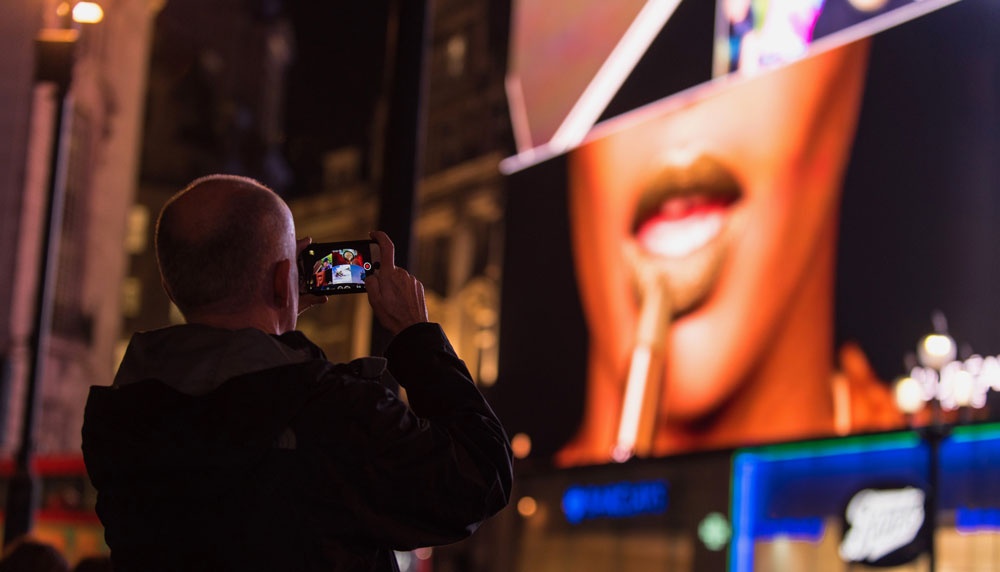
Introduction
Recently, shop owners and vendors have started to consider the use of creative lighting, including digital displays and interactive media, as an essential element of their retail strategy4 to attract residents as well as visitors/tourists in the hours after darkness (Figure 1). This trend has been seen in the increasing use of new installations inviting passers-by for an interactive dialogue via their visual content. Statistical analysis of the number one outdoor advertising company worldwide shows that its global revenue for the year 2017 increased by 2.3% to €3,471 million5. As the economy dominates even this emerging field, a conflict of interest is visible. On the one hand, the profit for the screen owner, advertising agency, product/services and screen manufacturer, on the other hand considering the screens as an integral part of the built environment6 and taking a human-centric design approach to aspects such as visual perception and attention, safety, health, and well-being, to name but a few. In our cities we often end up with a visual cacophony of moving images after the darkness falls. The screens are linked to the internet so the visual content, including ads, can be altered in real time. This relatively new trend of using dynamic images is in evidence all over the world. In view of this, how are the decisions regarding the screen’s location, size, brightness, content, etc., being made? Do the developers, architects, owners, designers and politicians ask themselves for whom they are designing public spaces in the first place and how these big digital screens may contribute to them? Who is making these complex decisions?7
Factors that attract our visual attention in the city after dark
Despite recent studies and knowledge8,9,10 there is still a lack of understanding concerning various aspects of these new media during the nighttime. There is no coherence – often these digital displays are designed without specialist knowledge or purpose. So far, little attention has been given to examining different attractors surrounding the interactive public display, i.e. people, artefacts, and stimuli that compete for people’s attention in urban settings and distract them from interacting with public displays11. Therefore, do we know enough about attracting human attention at night to make informed decisions on design of these screens and their content? Do they produce long term cognitive effects? What is the effect of light pollution on residents’ daily rhythm? Should digital public displays and their content be regulated more thoroughly?12,13
a. Views and vistas
When night falls, all the visual clues that are available during the daytime disappear. Light can ease navigation through the unknown built environment if it is designed correctly taking into consideration what we know about human visual perception. It is important that the display will be viewed properly from as many angles as possible and that its content can also be clearly seen and perceived. Therefore, performing a visibility study in order to identify distant, mid and close views and vistas of vertical planes with possible display locations can be essential for attracting attention (as these occupy a large percentage of our field of vision). One should also question the impact of large LED displays in relatively narrow streets as their viewing will be compromised.
b. Hierarchy in lighting contrast (brightness)
One of the main tools for creating visual hierarchy of buildings in the urban nightscape is lighting contrast, the other is colour. The former highlights the key areas of presented architectural compositions after dark and is an essential tool for revealing form (Figure 2). It is crucial to assess ambient brightness conditions before beginning to work on any design and specification, as these are very complex issues. The values of Luminance Contrast Ratio, which defines the brightness of the object with regard to the brightness of the background (both measured in cd/m2 as luminance) in such a way as to achieve a specific visual effect. In order to make an object stand out from its background, its brightness must be a minimum of two times greater than that of the background; otherwise, the human eye is unable to notice the difference. If the contrast is too great it can create disability14 and discomfort glare15.
c. Applied colour
According to colour psychology, colour can influence human perception and, for this reason, has been used extensively in marketing and branding strategies to affect consumers’ emotions and, therefore, their perception of goods and services. One should remember that the impact of colour differs depending on the individual and his/her age, gender and cultural background. The two most powerful colours widely used in LED outdoor advertising are red – this is associated with attention and it endorses enjoyment, interest and action, and blue, which characterises peacefulness and calmness, intelligence and strength. White, on the other hand, is neutral and simple. Its clarity and contrast make it work very well as a background colour. Lastly, the colour black has always been associated with elegance and class. It contrasts well with most colours pretty well and, if applied appropriately, endorses visual distinction and clarity.
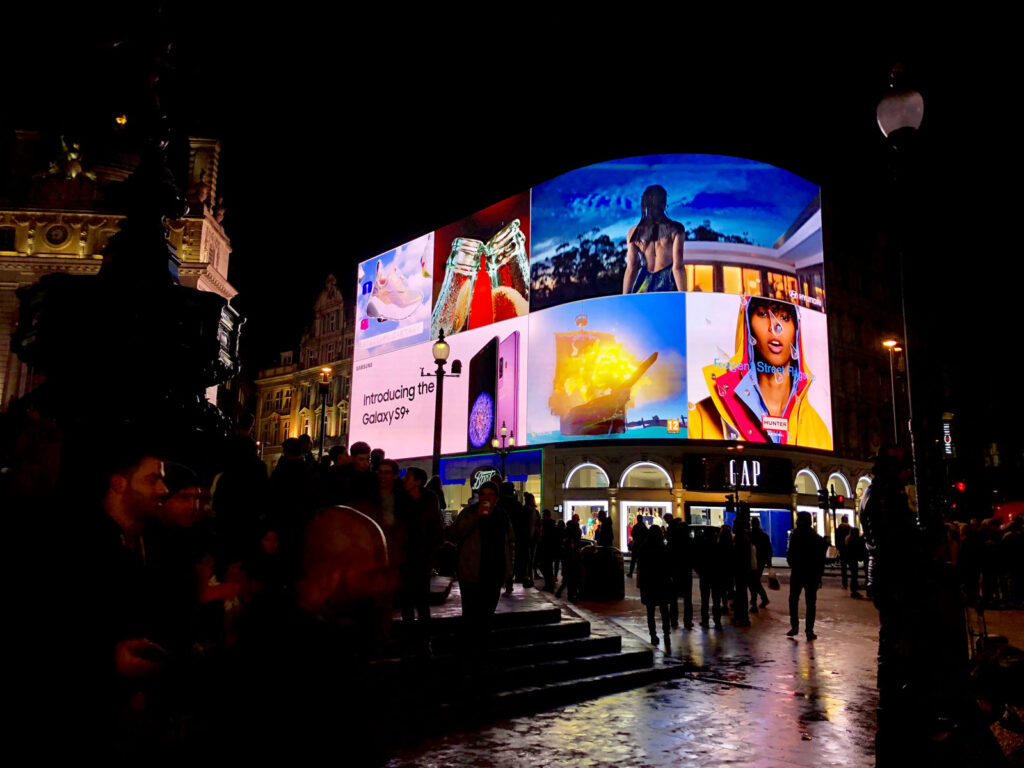
d. Position on the building’s façade
The position of a digital display on the building’s façade also plays an important role. Displays can be situated at the perimeter level, in the middle of the building or on the roof. All these locations are connected to previously mentioned close, mid and distant views (Figure 3).
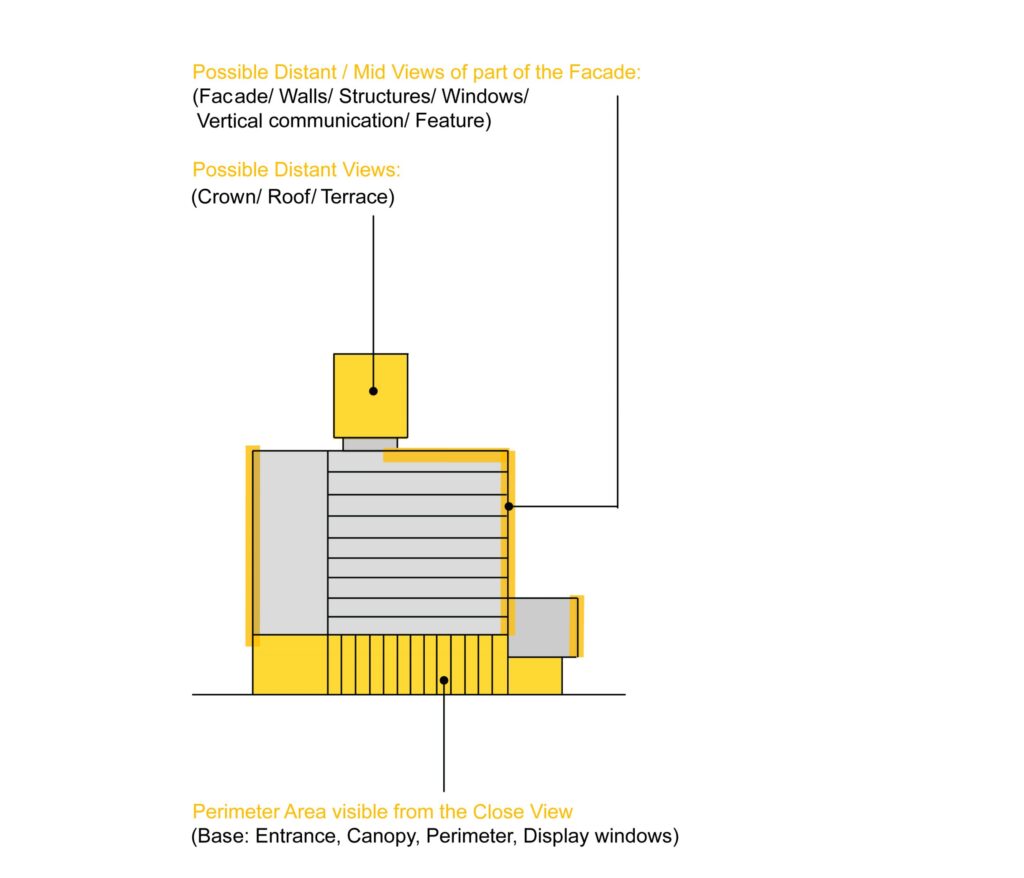
e. Display size
Today’s technology allows us to cover the whole façade of a building with an LED display. Not only can large surfaces be destructive and create traffic conflict because they distract the attention of drivers and pedestrians, but such large displays also create more uncontrolled lighting pollution in the form of glare, light trespass and sky glow. They can also increase energy consumption.
f. Pace of the images projected
If a video’s content is played faster than the speed of a person walking through the space (5km/h), the pedestrian cannot identify and absorb the displayed messages. Research indicates that perception of visual flow is distorted while we walk16. This means that the only people able to adequately appreciate the LED display are those who stand still to watch it.
g. Image resolution and viewing distance
The LED pixel pitch (the distance from the centre of an LED cluster (pixel) to the centre of the next LED cluster, measured in millimetres) impacts the resolution of the projected image. Hence, the “finer” the pixel pitch, the higher the resolution. There is a correlation between the resolution of the image and its viewing distance. As we move further away, the resolution pitch can increase (Figure 4). Low resolution displays can provide very beautiful visual aesthetics if the content is also visually attractive and appealing.
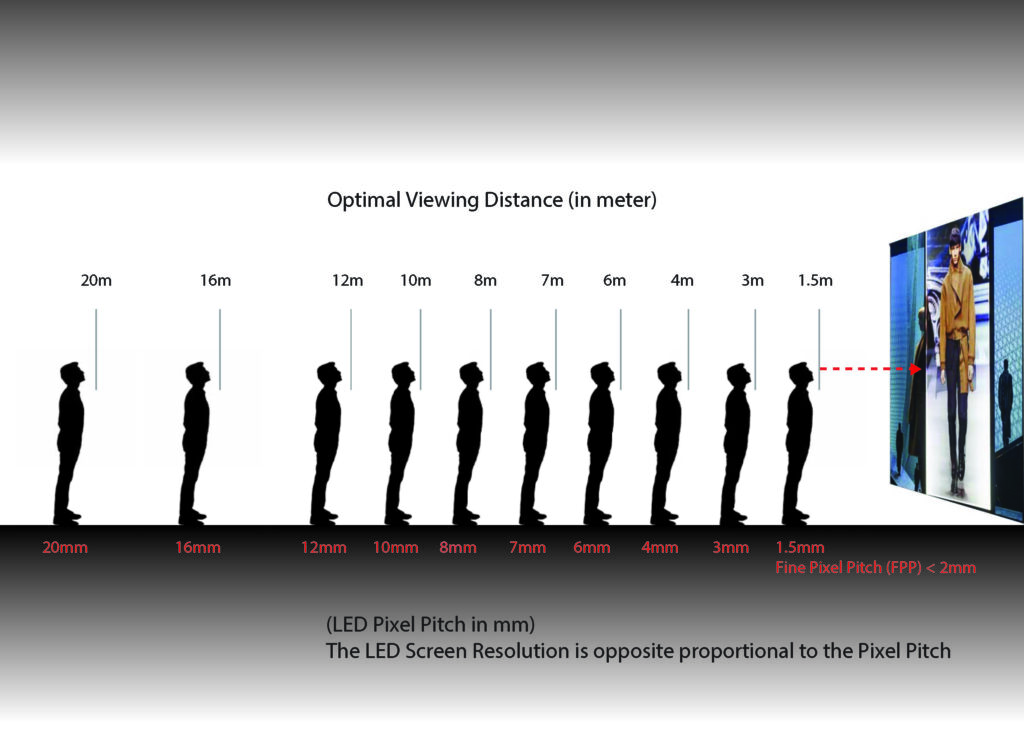
h. Creative content
It should be emphasised that an LED digital display is designed as an architectural part of the building, not as an added element after the construction. This includes its visible content. Seeking the guidance of an artistic curator or graphic designer who can be responsible for commissioning digital works on the façade of the building to avoid visual randomness is recommended if this is at all possible. An advertisement can also be a work of art.
How much light is too much?
We know today that artificial light has not only a visual effect but also a non-visual and biological effect. Consequently, placing LED displays in residential and recreational areas near urban parks should be avoided due to their potentially negative impact on human health and flora and fauna17. Artificial light at night (ALAN for short) is a rapidly increasing phenomenon and it is acknowledged to have global consequences on human health, such as cancer, diabetes, obesity and other diseases18. It is our duty to ensure the responsible application of light. Therefore, if an LED display on a building façade is located in a residential area, it should be no brighter than the illuminations on nearby streets, buildings and squares that operate during agreed curfew times. Providing lighting scene settings that are integrated with LED displays according to the time of the day/night, day of the week, season and weather should minimalise the adverse effects. Exemptions may be possible for agreed special events, celebrations and nominated areas. The same care, consideration and caution with lighting displays applies to natural areas such as parks, reserves, city gardens, rivers, ponds, and the ocean, etc., where flora and fauna require undisturbed hours of darkness. Ideally, all LED displays should be switched off one hour before sunset until one hour before sunrise. To be sure that the LED display does not exceed the permitted level of sky glow, cause light intrusion into windows or go beyond permitted building luminance, one can follow the allowances given by the environmental zones (Zone E0-Zone E4) for the urban context in which each project is located19.
‘Piccadilly Lights’ London, UK – Big Brother is watching you
Scholars of Media Architecture and Pervasive Displays have reported on ‘display blindness’ as a common problem for public displays20,21 .This refers to the situation where passers-by hardly notice or pay attention to the displays due to the fact that they expect to see unexciting, dull content.
Personalised ads delivered by the modern digital billboard are the answer to counteracting the ‘display blindness’ experience. New ‘Piccadilly Lights’ in the heart of London is an excellent example of an LED video display screen located in one of London’s busiest intersections (with 2 million people passing every week) and a prime advertising space using this upcoming responsive technology. The display screen that measures around 780m2 in total uses a camera’s sensor and monitors the area to acquire various data in order to build automatic reports about the audience to trigger more relevant advertising and content that will generate the maximum profits for various brands.
From passers-by, who account for more than 2/3 of overall visitors, demographic data such as age, ethnicity, gender, appearance, and even mood can be obtained using facial detection technology22. In this case, potential violation of privacy by such marketing surveillance should be called into question. From the perspective of car drivers, the manufacturer, model and/or colour of their car can be reported in order to create a targeted commercial. However, this approach seems to present additional safety issues where increased attention is required as car drivers, instead of looking at the road ahead, will look up towards the video display (Figure 5).
The display can also respond to local changes in weather and temperature.
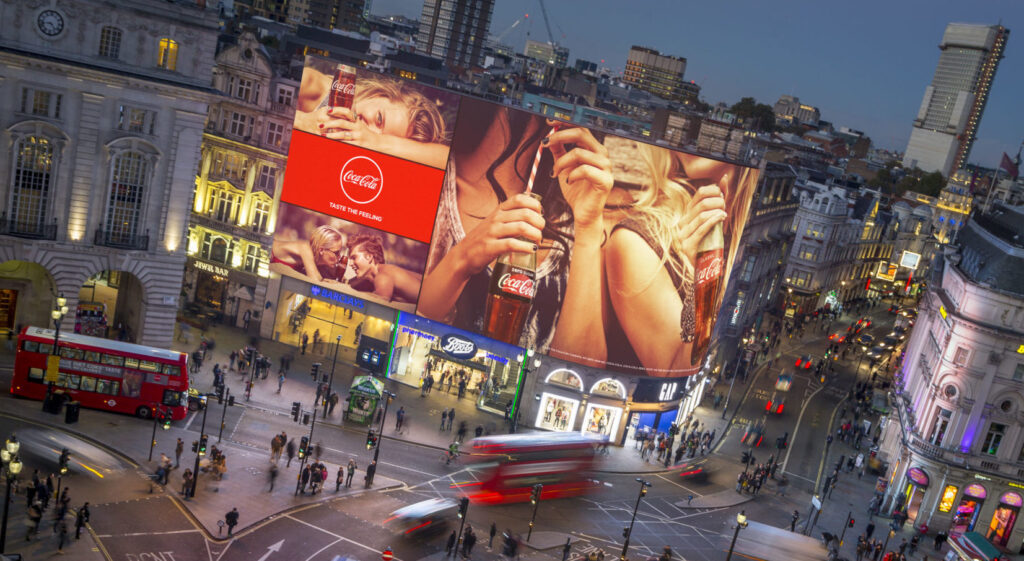
Call for new research and action
It always seems to be new technology that drives any design development with larger and brighter LED screens throughout the night, not human factors. But how to convince different interest groups that the latter is equally or even more important? This can be achieved by performing interdisciplinary research in this field on how to make decisions about a city and how digital and interactive media are experienced at night, supported by time based experience of a moving body with the use of new technologies and tools applied in neuroscience and human computer interaction (HCI). So far, these three have not been linked.
This paper represents a call for action to establish a research agenda that addresses complex sensory, social, spatial issues, interactional knowledge of the environment, human perception at night, and the science of lighting and control technology. New tools such as, for example, Mobile EEG can be used to record brain waves that could inform us how a person perceives the environment as she or he moves around within an urban space and experiences it. Eye-tracking technology is another tool that is useful to study gaze behaviours and cognition, and to determine what attracts attention. It has been used extensively in a lab environment to identify what draws visual attention and is helping to revise new ideas and extend our imagination by exploring the technology in a real world setting23. Another reason why this research is so important is the current lack of guidelines. This makes it extremely difficult for local authorities to make educated decisions when it comes to dealing with applications for building permits of this kind.
Final remarks and conclusion
When designing encounters that are stimulated through interactive media in today’s cities at night, we need to understand the urban experience of the different groups of people who inhabit that space, with a varied range of cognitive, physical and perceptual abilities. We should take into account the dynamic aspects of the visual space and attention, including viewing angles and distance from the observer, the movements of the screen content (the moving images and their various directions or transition times to absorb the message) as well as the moving body/vehicle in terms of speed and directionality (parallel or perpendicular to the screen). Other aspects such as the material used (property of the LED display) and how it affects the viewer and its impact on the surrounding environment and how to correctly embed the interactive public displays within the existing dynamic urban attractors also need to be considered. Lastly, light sources used and the property of light they emit and their effect on the circadian rhythm of the residents/visitors must be examined. As the full range of factors is not yet known, we suggest that bringing together Media Architecture,Urban Design, HCI, Lighting Design and Neuroscience supported by new cognitive tools will aid the generation of knowledge that can help in the formation of potential guidelines concerning the implementation of the interactive media as an integral part of the sensorial ecology within the built environment. Designing LED digital outdoor advertising and interactive media in the urban context so that it not only enhances our visual nighttime experience, but also ensures the comfort, safety and quality of life of the end user should be a priority.
References
- Cheong, Y. (2017, May). Market Opportunities for LED Video Display Technology. Unpublished PowerPoint slides presented at the International LED Summit on the occasion of LED Expo Thailand 2018, Bangkok, Thailand.
- Müller, J., Wilmsmann, D., Exeler, J.,, Buzeck , M., Schmidt ,A., Jay, T. and Krüger, A. Display Blindness: The Effect of Expectations on Attention towards Digital Signage, Proceedings of the 7th International Conference on Pervasive Computing, May 11-14, 2009, Nara, Japan [doi>10.1007/978-3-642-01516-8_1].
- Cave, A. (2015, Jan 03). Bus shelters the future for digital advertising, says Clear Channel boss. The Telegraph. Retrieved from https://www.telegraph.co.uk/finance/newsbysector/mediatechnologyandtelecoms/11323483/Bus-shelters-the-future-for-digital-advertising-says-Clear-Channel-boss.html [17.08.2018].
- Zielinska-Dabkowska, K.M., Hartmann, J. (2016). LED outdoor advertising in the urban context. Case study of “Walk”: a video installation integrated into the façade of a store in Zürich/CH, Professional Lighting Design (PLD) Magazine, no. 101, pp. 52-58.
- Retrieved from https://www.jcdecaux.com/press-releases/full-year-2017-revenue [17.08.2018].
- Fatah gen Schieck, A. (2006). Towards an integrated architectural media space. firstmonday, 11 (4). Retrieved from http://firstmonday.org/ojs/index.php/fm/article/view/1550/1465 [17.08.2018].
- Fatah gen. Schieck, A., Boddington, G., & Fink, P. (2009). Framework for the implementation of urban big screens in the public space. London: UCL. Retrieved from http://www.bodydataspace.net/wp-content/uploads/SCREAM_Framework_Jan2009.pdf.
- Purves, D., Lotto, B.R., Surajit, N. (2012). Why We See What We Do. American Scientist, vol. 90, Issue 3, p.236.
- Livingstone, M. (2002). Vision and art: The biology of seeing. New York, N.Y: Harry N. Abrams.
- Morris, N. (2011). Night walking: Darkness and sensory perception in a night-time landscape installation. Cultural Geographies, 18(3), 315-342. Retrieved from http://www.jstor.org/stable/44251415 [17.08.2018].
- Memarovic, N., Fatah gen. Schieck, A., Kostopoulou, E., Behrens, M., & Al-Sayed, K. (2014). Attention, An Interactive Display Is Running! Integrating Interactive Public Display Within Urban Dis(At)tractors. Screencity Journal, issue 4, Special Issue on Spaces, Images, Communication: Improving New Urban Models, 2014.
- Zielinska-Dabkowska, K.M., Xavia, K. (2018). The Importance of Healthy Nocturnal Placemaking. Global Approaches to Reduce Light Pollution from Outdoor Media Architecture, Animated LED Displays and Signs. Proceedings of the 5th ACM Conference Media Architecture Biennale (MAB ’18). Beijing, China, November 13 – 16, 2018. ACM, New York, NY, USA.
- Ibid 7.
- Aslam, T.M., Haider, D., Murray, I.J. (2007). Principles of disability glare measurement: an ophthalmological perspective. Acta Ophthalmol. Scand. 2007: 85: 354–360.
- Retrieved from https://www.lrc.rpi.edu/programs/nlpip/lightinganswers/lightpollution/glare.asp [17.08.2018].
- Durgin, F.H. (2009). When walking makes perception better. Current Directions in Psychological Science 18:43–7.
- Zielinska-Dabkowska K.M. (2018). Make lighting healthier. Nature 553 (7688) pp. 274-276, [doi>:10.1038/d41586-018-00568-7].
- Cho, Y., Ryu, S.H., Lee, B.R., Kim, K.H., Lee, E., Choi, J. (2015). Effects of artificial light at night on human health: A literature review of observational and experimental studies applied to exposure assessment. Chronobiology international. 32. 1-17, [doi>:10.3109/07420528.2015.1073158].
- Commission Internationale de l’Eclairage (CIE). (2017). Guide on the Limitation of the Effects of Obtrusive Light from Outdoor Lighting Installations. CIE Publication 150, 2nd-edition. Vienna: CIE. Retrieved from http://www.cie.co.at/publications/guide-limitation-effects-obtrusive-light-outdoor-lighting-installations- [17.08.2018].
- Ibid 11.
- Huang, E., Koster, A., Borchers, J. (2008). Overcoming assumptions and uncovering practices: When does the public really look at public displays? In: Indulska, J., Patterson, D.J., Rodden, T., Ott, M. (eds.) Pervasive 2008. LNCS, vol. 5013, pp. 228–243. Heidelberg: Springer.
- Retrieved from https://landsec.com/policies/privacy-policy/piccadilly-lights [17.08.2018].
- Dalton, N.S., Collins, E., Marshall, P. (2015). Display Blindness?: Looking Again at the Visibility of Situated Displays using Eye-tracking, Proceedings of the 33rd Annual ACM Conference on Human Factors in Computing Systems, April 18-23, 2015, Seoul, Republic of Korea.
